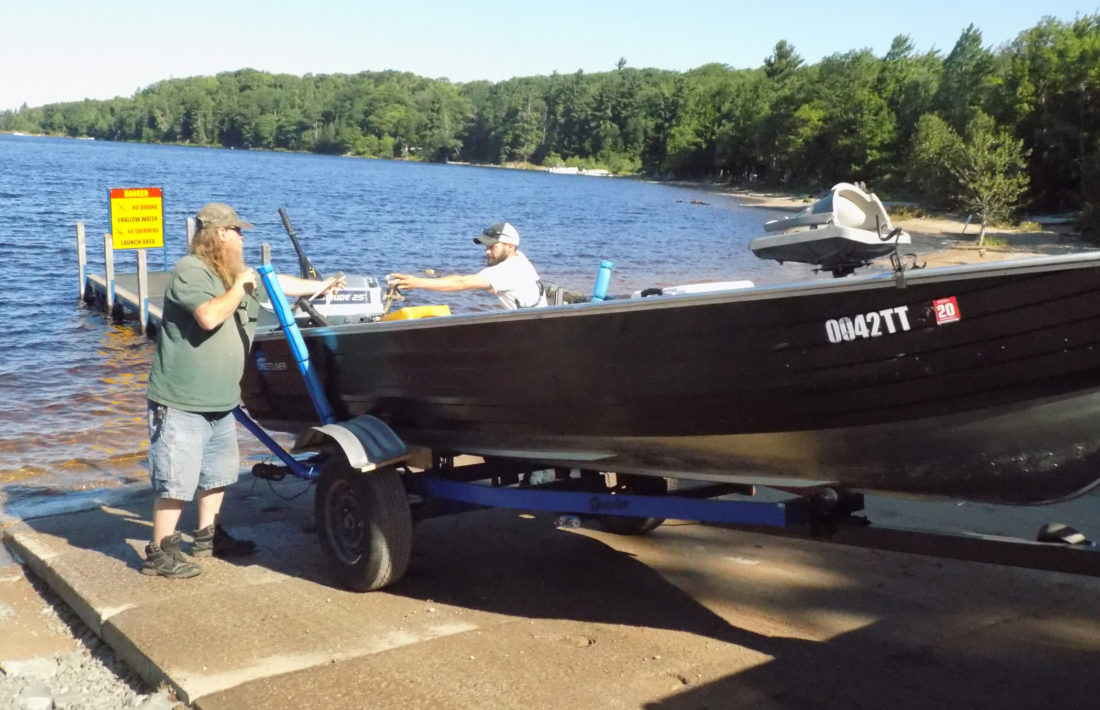Basin blitz
Invasive species focus of educational event

Will Cox, left, of Kiva, and Zach Welters, of Ishpeming, prepare to launch at boat Saturday morning at the Hoist Basin. The Hoist Basin was the site of the annual Aquatic Invasive Species Landing Blitz. (Journal photo by Christie Bleck)
NEGAUNEE — In a way, one of the main purposes of the annual Aquatic Invasive Species Landing Blitz, which took place Saturday at the Hoist Basin in Negaunee Township, is to keep the Dead River from going dead.
The river contains the Hoist Basin, where officials from the Upper Peninsula Power Company, the Lake to Lake Cooperative Invasive Species Management Area, the Michigan Department of Natural Resources and Dead River Campers Inc. hosted the event. The goal of the blitz was to focus on protecting the Great Lakes and inland waterways from harmful aquatic hitchhikers that can attach to recreational watercraft.
Elise Desjarlais, coordinator for the Lake to Lake Cooperative, helped staff an educational table full of materials on aquatic invasives for boaters and anglers, and anyone who stopped by, to learn about this pressing environmental issue.
“We just want to educate people on invasive species, what they can do to prevent it, what they can do to ID it, who they can contact if they think they found something,” Desjarlais said.
Invasive species typically are non-native species that overtake native ones, altering the local landscape.
“They just outcompete any and all native species,” Desjarlais said. “They kind of monopolize a water body or plant colony.”
Each body of water has its own particular invasive species problem, and Hoist Basin is no exception.
“Here we’re always keeping a lookout for things like purple loosestrife,” Desjarlais said.
That plant, which as its name says, is purple, and could be considered aesthetic by some people. However, its prolific spread can take over areas of lakes.
Another species that causes concern, she said, is Eurasian watermilfoil.
This highly invasive plant forms dense mats near the water surface. These mats can entangle motor boat propellers and interfere with swimming.
Ironically, watercraft and trailers can further the spread of this species.
Desjarlais pointed out that Hoist Basin contains native watermilfoil, which would be one of the first plants to go should the Eurasian variety take over.
Even non-plants can cause problems.
One of these is a bivalve native to Russia.
“Zebra mussels are always a big item to keep an eye out for, and there’s a slew of others that I could probably name off, but those are probably the top three that we’re kind of trying to make awareness of,” Desjarlais said.
Invasive species, unfortunately, continue to be a problem through the state of Michigan.
Other problem species include plants such as European frogbit, parrot feather and water hyacinth, and fish such as silver carp and snakehead.
“They’re definitely holding their own and they’re kind of starting to creep in, so we’re trying to keep them at bay as long as possible,” Desjarlais said. “If you can keep your lake clear and free as long as possible, that’s the best-case scenario, and awareness is one of the best ways to do that. Make sure people aren’t bringing it in.”
The official slogan for the initiative, she said, is “clean, drain, dry.”
Desjarlais has some tips for boaters who want to be conscious of the invasives problem.
“Always drain out every ounce of water that you can out of your boat — if you have a livewell, your bilge, everything,” Desjarlais said. “If you’re pulling a trailer out and you see a bunch of vegetation attached to it, clear all that off. Don’t take it with you anywhere.”
She recommended boaters dry their watercraft for at least five to seven days between moving to other bodies of water, but if that’s not possible, a heated pressure washer is the best way to clean them.
How did these species get to the Great Lakes area to begin with? Probably ballast water from ocean liners, she said.
Whatever the reason for non-native species invading a body of water, they could affect outdoor enthusiasts like Ishpeming’s Zach Welters.
“I pretty much only go to this lake,” Welters said of the Hoist Basin.
Jim Grundstrom, president of Dead Rivers Campers, also attended Saturday’s blitz.
“We have a vested interest in educating all the members — the residents of the Hoist Basin perimeter — but also our visitors because this is a public launch ramp put here by the Department of Natural Resources and UPPCO,” Grundstrom said. “So, if we can help them be smarter boaters — not bring disease stuff into the Hoist Basin or out of the Hoist Basin to the next lake they go to — it’s really cool that Elise is here on behalf of this to try and make us all better at enjoying the water.”
For information about aquatic as well as terrestrial invasive species, visit michigan.gov/invasives or l2lcisma.org.
Christie Bleck can be reached at 906-228-2500, ext. 250. Her email address is cbleck@miningjournal.net.



